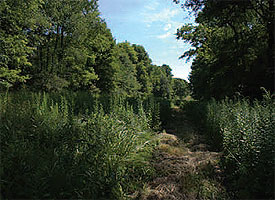WPC Updates its Strategic Plan

The 2012-2014 strategic plan states that WPC will continue to “significantly accelerate land conservation in high-value conservation areas” as it did with the acquisition in February of 55 acres in Venango County to permanently protect the habitat of the eastern massasauga rattlesnake (Sistrurus catenatus catenatus), a state-endangered species. This strategic initiative is one of 11 identified in the 2012-2014 Strategic Plan.
As 2011 drew to a close, so did the third year of the Western Pennsylvania Conservancy’s three-year strategic plan. Specific accomplishments of the 2009–2011 plan will be highlighted in the 2011 Annual Report, which will be published this summer.
Work began early last year to prepare the 2012-2014 WPC strategic plan. Staff members from all divisions of the Conservancy and members of the board of directors worked together over several months to create the plan. These strategies articulate the organization’s vision and projected outcomes for the next three years.
The new plan will guide efforts to advance the mission of the Conservancy over the next three years. It sets forth goals and outcomes for programs in core areas, including land conservation and stewardship, natural heritage, watershed conservation, gardens and greenspaces, and Fallingwater. The strategies will drive the Conservancy’s work and serve to keep the organization focused on successful implementation of mission-driven work.
These strategic initiatives, and specific measurable outcomes that have been established for each of them, will guide the Conservancy’s work over the next three years:
Land Conservation
We will significantly accelerate land conservation in high-value conservation areas and areas of regional and local importance by implementing innovative strategies and proven methods, and investing in strategic partnerships. This will result in permanent protection of wildlife and its habitat, clean water, forests and exceptional natural landscapes for future generations.
Land Stewardship
We will responsibly steward the properties we own and the conservation easements we hold by committing sufficient resources to monitoring sustainable management guided by the best available conservation science, and building awareness of our properties so that we protect and enhance the conservation values of the properties in perpetuity.
Watershed Conservation
We will protect the most ecologically significant watersheds while restoring those that are impaired by implementing projects based on sound science and working with partners to provide leadership and technical assistance. This will result in improved water quality, aquatic biodiversity, recreational opportunities and well being of communities.
Natural Heritage
We will provide the best available and most up-to-date scientific information and expertise to decision-makers and the public through research, collection, analysis and monitoring to protect the biodiversity of Pennsylvania’s natural resources.
Fallingwater
We will preserve Frank Lloyd Wright’s Fallingwater and conserve the site for which it was designed, interpreting the house and the site and their history for present and future generations of the world community.
Gardens and Greenspace
We will enhance Western Pennsylvania’s cities and towns by implementing high impact approaches to promote healthy environments and livable neighborhoods. This will in turn help to revitalize communities and reduce pressure on undeveloped lands and natural resources.
Government and Policy
We will take a leadership role in fostering and promoting sound and responsible public policies by building awareness and engagement of public officials to advance and support conservation and restoration of natural resources, historic preservation and community revitalization.
Energy Development Impacts
We will comprehensively address the impact of Marcellus Shale Gas and other energy development on natural resources in Pennsylvania by advancing sound and responsible public policy, assessing and monitoring impacts, and informing our land protection practices to minimize adverse impacts to our land, water, wildlife and natural areas.
Communication and Engagement
We will increase the visibility and awareness of our work using various communication platforms, with an emphasis on electronic media, to generate additional support and engagement necessary to advance our work.
Building Capacity
We will build organizational capacity through private support by significantly expanding our private fundraising outcomes so that we can positively impact the quality of life in the region through our work.
Diversity
We will build a diverse and inclusive organization by undertaking focused initiatives and partnerships to engage a broader community.
